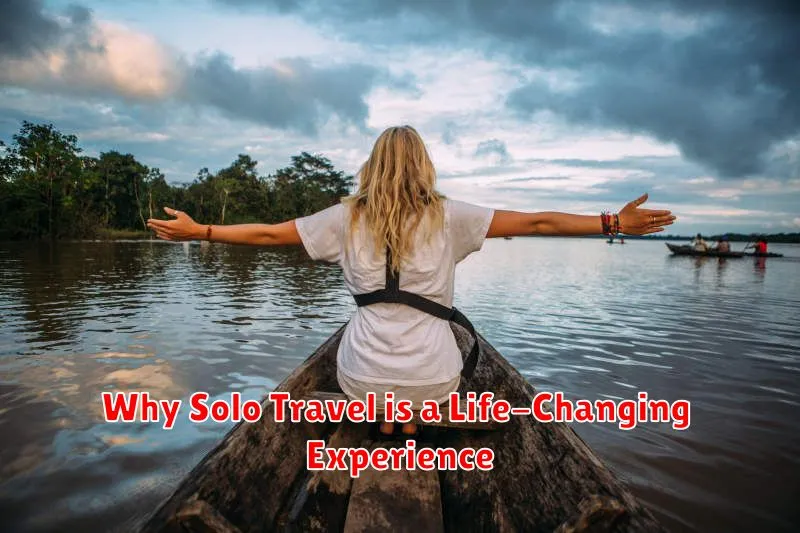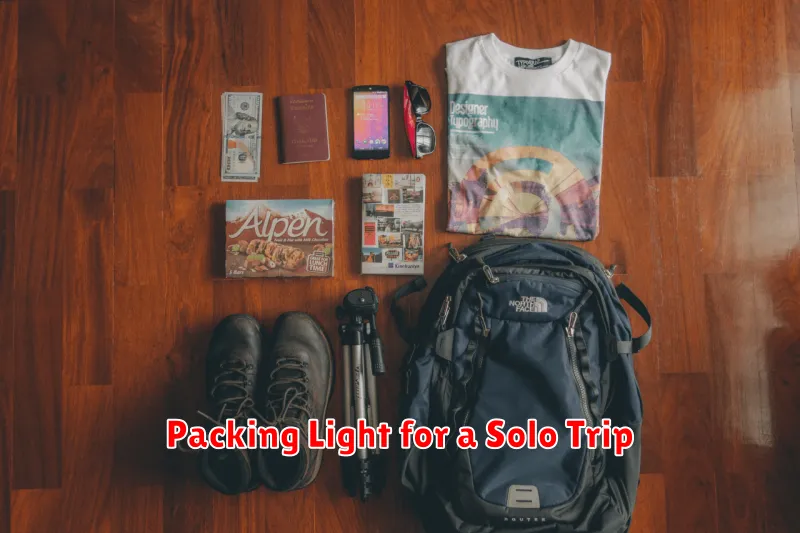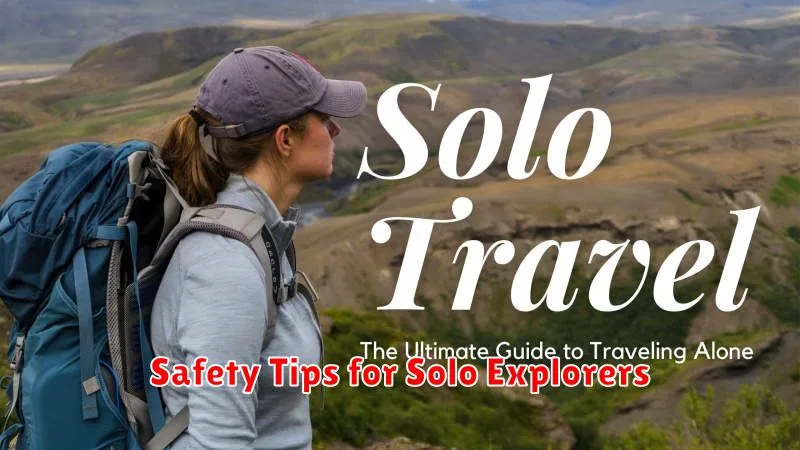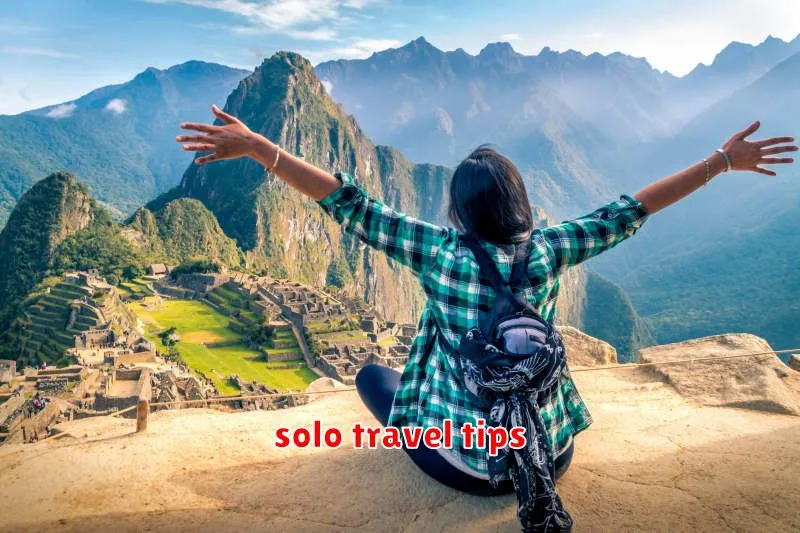Ready for the adventure of a lifetime? Planning a solo travel adventure can seem daunting, but with the right preparation, it can be incredibly rewarding. This guide will walk you through every step, from choosing the perfect destination and securing affordable flights to packing light and staying safe. Learn how to create an unforgettable solo trip filled with exciting experiences, personal growth, and breathtaking memories. Discover the freedom and self-discovery that comes with independent travel, and conquer your fears by planning your own epic solo adventure today!
Why Solo Travel is a Life-Changing Experience

Solo travel isn’t just about ticking off destinations on a bucket list; it’s a transformative journey of self-discovery. Stepping outside your comfort zone, navigating unfamiliar landscapes and cultures independently fosters independence and self-reliance. You learn to trust your instincts, problem-solve creatively, and adapt to unexpected situations – all invaluable life skills.
Beyond practical skills, solo travel cultivates profound personal growth. The freedom to dictate your itinerary allows you to deeply connect with your inner self. Unburdened by the expectations and compromises of travel companions, you have ample time for introspection, reflection, and pursuing your own interests at your own pace. This can lead to a greater understanding of your strengths, weaknesses, and values, ultimately shaping your personal identity.
Furthermore, the unique experiences and encounters you’ll have while traveling solo are irreplaceable. You’ll connect with locals on a deeper level, forging meaningful relationships that enrich your journey and broaden your perspectives. Embracing spontaneity and embracing the unknown fosters a sense of adventure and vulnerability, leading to unforgettable memories and a newfound appreciation for the beauty of the world and the resilience of the human spirit.
In short, solo travel is a powerful catalyst for personal growth. It pushes you beyond your boundaries, strengthens your resilience, and deepens your understanding of yourself and the world around you. It’s an investment in your personal development that yields immeasurable rewards.
How to Choose a Safe Destination for Solo Travelers
Choosing a safe destination is paramount for solo travelers. Prioritize countries with low crime rates and a strong sense of tourist safety. Research specific areas within a country, as safety can vary significantly.
Look for destinations with reliable infrastructure, including readily available transportation and communication systems. Good infrastructure ensures you can easily navigate and get help if needed. Consider destinations with accessible healthcare in case of emergencies.
Read reviews and travel blogs from other solo female travelers (if applicable) to gain insights into their experiences. Pay attention to accounts of personal safety and any challenges faced. Forums and online communities can provide valuable, up-to-date information.
Learn a few basic phrases in the local language. While not a guarantee of safety, demonstrating an effort to communicate respectfully can be beneficial. Before you go, inform someone trustworthy of your itinerary and check in regularly.
Ultimately, thorough research and a realistic assessment of your own comfort level are key to selecting a safe and enjoyable solo travel destination. Remember, trust your gut; if a place doesn’t feel right, it’s okay to reconsider.
Packing Light for a Solo Trip

Packing light for a solo trip is crucial for several reasons. It makes navigating airports and public transport much easier, allowing for greater flexibility and spontaneity. Less luggage means less to worry about, reducing stress and freeing you up to enjoy your adventure.
Prioritize versatility. Choose clothing items that can be mixed and matched to create multiple outfits. Think neutral colors and fabrics that don’t wrinkle easily. Consider the climate of your destination and pack accordingly. Check the weather forecast before you leave, and be prepared for both warm and cool conditions.
Roll, don’t fold, your clothes to save space and prevent wrinkles. Use packing cubes to organize your belongings and compress your clothing. A carry-on suitcase is ideal for solo travel; avoid checking baggage whenever possible. Only pack the essentials – toiletries, medications, and important documents.
Leave room for souvenirs! You’ll likely want to bring home some mementos from your trip, so don’t overpack initially. You can always buy necessities at your destination if needed. Remember, you can always do laundry along the way. Embrace the minimalist approach – it’ll enhance your solo travel experience.
Tips for Staying Connected with Family and Friends
Going solo doesn’t mean going dark. Staying connected with loved ones while traveling alone is important for your well-being and theirs. Here are a few simple yet effective tips:
Schedule regular calls or video chats: Set aside specific times to connect, perhaps once a week or even every few days. This gives everyone something to look forward to and helps bridge the distance.
Utilize messaging apps: Apps like WhatsApp, Messenger, or Telegram allow for quick updates, sharing photos, and even voice notes. Send short messages throughout the day to keep everyone in the loop.
Share your itinerary (partially): Let your family and friends know your general location and plans, but don’t overshare. This offers peace of mind without compromising your personal safety or spontaneity.
Post on social media (carefully): If you’re comfortable sharing your travel experiences online, social media is a great way to keep in touch visually and update everyone at once. Be mindful of your privacy settings, however.
Send postcards: A classic touch! A handwritten postcard is a tangible reminder of your trip and a thoughtful way to stay connected in a more personal manner.
Remember time zones: Be considerate of the time difference and try to schedule communication when it’s convenient for everyone involved.
Don’t feel pressured to be constantly connected: While staying in touch is important, remember to enjoy your solo adventure and disconnect occasionally to fully immerse yourself in your experience. Finding the right balance is key.
How to Meet Other Travelers
Meeting fellow travelers is a fantastic way to enrich your solo adventure. Embrace shared experiences and make lasting connections by actively seeking out opportunities to connect.
Hostels are renowned for their social atmosphere. Dormitory rooms provide instant opportunities for interaction, and many hostels organize social events like pub crawls or walking tours. Take advantage of these!
Join group tours or activities. Whether it’s a cooking class, a hiking excursion, or a guided city tour, shared activities offer natural conversation starters and a chance to bond with like-minded individuals.
Utilize travel apps and forums. Many platforms connect travelers with similar itineraries. Apps like Meetup or Facebook groups dedicated to specific destinations can help you find others with overlapping interests and plans.
Be open and approachable. Strike up conversations with people you encounter – fellow diners, those waiting in line at attractions, or even your seatmate on a bus. A simple “hello” can lead to fascinating interactions.
Participate in free walking tours. These tours are a great way to explore a new city and meet fellow travelers simultaneously. The shared experience fosters camaraderie.
Don’t be afraid to eat alone. Many solo travelers dine alone, but don’t let that discourage you from striking up conversations with those nearby. A friendly comment about the food can be a perfect icebreaker.
Remember, be respectful of personal space and boundaries, but don’t be shy about extending a friendly hand to fellow adventurers. Making connections can significantly enhance your solo travel experience.
Creating a Flexible Itinerary
One of the greatest aspects of solo travel is the freedom to change your plans on a whim. A rigid itinerary can stifle spontaneity and limit your ability to discover hidden gems or unexpected opportunities. Instead of meticulously planning every minute, embrace the art of the flexible itinerary.
Start with a loose framework. Identify a few key destinations or activities you absolutely want to experience. Book accommodations for the first few nights to give you a sense of security, but leave the rest open. This allows for greater flexibility to extend your stay in a place you love or quickly move on from somewhere that doesn’t quite meet your expectations.
Utilize open-ended transportation. Instead of pre-booking every train or bus ticket, consider purchasing open-ended passes or simply showing up and purchasing tickets as needed. This provides options to change your route or spend more time exploring specific areas.
Embrace the unexpected. Be open to detours, spontaneous encounters, and last-minute invitations. Sometimes the best travel experiences come from unplanned adventures. A flexible itinerary allows you to fully embrace these opportunities.
Remember, the goal is to create a foundation, not a rigid schedule. This approach empowers you to experience the joy of serendipity and authentic connection with your surroundings while ensuring you still see and do the things most important to you.
Managing Finances While Traveling Alone
Solo travel offers unparalleled freedom, but careful financial planning is crucial. Before you go, create a realistic budget encompassing flights, accommodation, activities, food, and unexpected expenses. Consider using a budgeting app to track your spending in real-time.
Researching costs beforehand is key. Look into average daily expenses in your destination and factor in potential price fluctuations. Booking flights and accommodation in advance can often lead to significant savings. Explore different payment options, including using travel credit cards that offer rewards and travel insurance.
While traveling, be mindful of your spending habits. Take advantage of free activities like walking tours and exploring local parks. Opt for affordable food choices, such as street food or local markets, instead of always dining in restaurants. Remember to keep your valuables secure and be aware of potential scams to avoid unnecessary financial losses.
Consider carrying a mix of cash and cards for flexibility. Inform your bank about your travel plans to avoid any issues with card usage abroad. Regularly monitor your bank account and credit card statements to ensure there are no unauthorized transactions.
Finally, building an emergency fund before your trip is highly recommended. This buffer will cover unexpected costs, ensuring a smooth and stress-free solo adventure, regardless of any unforeseen circumstances.
Safety Tips for Solo Explorers

Embarking on a solo adventure is exhilarating, but prioritizing safety is paramount. Thorough research is your first line of defense. Before you go, research your destination, understanding local laws, customs, and potential risks. Share your itinerary with a trusted friend or family member, including flight details and accommodation information.
Stay connected. Inform someone of your daily plans and check in regularly. Consider investing in a local SIM card for easy communication, or a reliable international roaming plan. Download offline maps and essential travel apps before your trip, to ensure you can navigate even without internet access.
Trust your instincts. If a situation feels unsafe, remove yourself immediately. Avoid walking alone at night in unfamiliar areas, and be mindful of your surroundings. Be aware of your belongings at all times, keeping valuables secure and avoiding displaying expensive items.
Learn basic self-defense. While hopefully never needed, knowing a few basic self-defense techniques can boost your confidence and preparedness. Also, familiarize yourself with emergency contact numbers for your destination.
Pack smart. Include essential medications, a first-aid kit, copies of important documents, and a portable charger. Consider travel insurance that covers medical emergencies and evacuations. Remember, responsible solo travel means being prepared for the unexpected.
How to Overcome Loneliness on Solo Trips
Embracing solo travel offers unparalleled freedom and self-discovery, but feelings of loneliness can sometimes arise. Preparation is key to mitigating this. Before you go, plan engaging activities that naturally foster connection. This could involve joining a walking tour, taking a cooking class, or signing up for a day trip with a local guide.
Connecting with others doesn’t always require structured activities. Strike up conversations with fellow travelers in hostels, cafes, or on tours. A simple “hello” can lead to unexpected friendships. Remember, many others are also traveling solo and may appreciate the company. Don’t be afraid to initiate interactions – even a brief chat can lift your spirits.
Embrace solitude as an opportunity. Solo travel is a chance for introspection and self-reflection. Use downtime to journal, read a book, or simply enjoy the peace and quiet. Mindfulness practices like meditation can help manage any feelings of isolation. Remember, loneliness is a temporary emotion; it doesn’t define your experience.
Document your journey. Taking photos, writing in a journal, or even creating a travel vlog can help you process your experiences and create lasting memories. This can be particularly helpful when reflecting on your trip after you return home. Sharing your experiences online with friends and family can also combat feelings of isolation.
Finally, be kind to yourself. It’s perfectly normal to feel a little lonely at times, especially when traveling alone. Allow yourself to feel these emotions without judgment, and remember that the experience is ultimately enriching and rewarding. Focus on the positive aspects of your journey and celebrate your courage and independence.
The Importance of Trusting Your Instincts
Solo travel is all about embracing the unknown, and a big part of that is learning to trust your gut. Your instincts are often your best guide, especially in unfamiliar situations. That nagging feeling that a certain place or person isn’t right? Listen to it. It’s better to err on the side of caution than to ignore a warning sign.
This doesn’t mean you should be paralyzed by fear. It’s about finding a balance between being adventurous and being safe. If a situation feels uncomfortable, even if you can’t pinpoint exactly why, remove yourself. Trust your internal compass to lead you towards positive experiences and away from potential risks.
Developing this intuition takes practice. Pay attention to your body language – a racing heart or a feeling of unease are valuable signals. Over time, you’ll become more adept at recognizing these cues and making informed decisions based on your internal wisdom. Remember, your safety and well-being are paramount on your solo adventure. Trusting your instincts is a vital tool in ensuring that.

